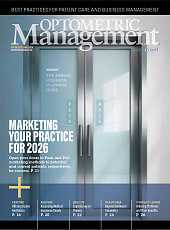This article was originally published in a sponsored newsletter.
Scleral lenses are widely used in the management of ocular surface disease (OSD).1Scleral lenses are well-tolerated and effective in managing dry eye disease (DED), demonstrating improvements in symptoms and visual acuity with minimal complications.1Patient-reported outcomes of scleral lens (SL) wear indicate a significant positive impact on ocular comfort and quality of life.2 Several studies have shown improvements in dry eye symptoms, demonstrated by reductions in Ocular Surface Disease Index (OSDI) scores, following SL therapy for various indications.3-7
Scleral lenses are useful for managing all levels of dry eye, ranging from mild to severe. Since scleral lenses bathe and protect the ocular surface, they may be considered an advantageous option for individuals with all forms of DED, including mild and moderate DED. Therapeutic indications for scleral lenses for OSD encompass dry eye disease syndrome, exposure keratitis, neurotrophic keratitis, graft-versus-host disease, Stevens-Johnson syndrome, ocular cicatricial pemphigoid, chemical burns, limbal stem cell deficiency, Sjögren’s disease, other systemic autoimmune diseases, persistent epithelial defects, and neuropathic ocular pain.8-10
Cyclosporine topical ophthalmic emulsion 0.05% was approved by the U.S. Food and Drug Administration (FDA) in 2003 and is a topical pharmaceutical option for the treatment of keratoconjunctivitis sicca. The immunomodulating ophthalmic emulsion targets ocular surface inflammation by inhibiting T-cell activation and disrupting the subsequent cascade of inflammatory cytokines, thus, decreasing disease progression due to its specific and reversible action on T cells.11,12 The preservative-free nature of this emulsion is important, as prolonged exposure to preservatives within the fluid reservoir could lead to severe corneal epithelial damage and is thus contraindicated. Topical ophthalmic cyclosporine 0.05% is safe, tolerable, and efficacious when used on-label.
A recent pilot study evaluated the tolerability of using SLs as a delivery system for preservative-free cyclosporine 0.05% to treat dry eye disease.13 Fourteen current, bilateral, daily wearers of SLs for more than six months with a baseline OSDI of 13 or greater were enrolled in the study. All individuals were required to have a baseline corneal fluorescein staining score of two or higher, based on the combined scores of both eyes, using the National Eye Institute grading scale for corneal fluorescein staining. A single practitioner at one eyecare center evaluated all individuals.
Nine subjects (18 eyes) completed the study protocol. Of the participants who completed all study visits, four were female and five were male. Participant ages ranged from 38 to 73 years, with a mean age of 54.33 ± 11.54 years. All subjects had DED, and seven of the nine also had corneal ectasia. All lenses had standard plasma treatment without a polyethylene glycol coating. Each individual was either already using or willing to transition to buffered preservative-free normal saline as the reservoir-filling solution.
One drop of cyclosporine 0.05% was placed in the lens reservoir, and the rest was filled with preservative-free normal saline. The lens was worn for six hours, after which it was removed, and the protocol was repeated for an additional four hours of wear or more. Symptom and sign data were collected at baseline, one week, and one month.
After one month, OSDI improved by a mean of 3.83 ± 6.87 from baseline (p = 0.07). There was no statistically significant change in best-corrected visual acuity. With slit lamp examination evaluation at one month, without comparison to the placebo, there was a statistically significant improvement (p < 0.05) in mean per individual and mean per eye corneal fluorescein staining, conjunctival lissamine staining, and conjunctival hyperemia.
Using scleral lenses as a drug delivery system for cyclosporine 0.05% was well tolerated, as evidenced by improvements in ocular surface signs and symptoms. Results from this pilot study suggest potential efficacy; however, a larger clinical trial is necessary to further evaluate and confirm these findings, including long-term safety, tolerability, and therapeutic outcomes.
Scleral lenses are useful for managing all levels of dry eye, ranging from mild to severe. Since scleral lenses bathe and protect the ocular surface, they may be considered an advantageous option for individuals with all forms of DED, including mild and moderate DED. Therapeutic indications for scleral lenses for OSD encompass dry eye disease syndrome, exposure keratitis, neurotrophic keratitis, graft-versus-host disease, Stevens-Johnson syndrome, ocular cicatricial pemphigoid, chemical burns, limbal stem cell deficiency, Sjögren’s disease, other systemic autoimmune diseases, persistent epithelial defects, and neuropathic ocular pain.8-10
Cyclosporine topical ophthalmic emulsion 0.05% was approved by the U.S. Food and Drug Administration (FDA) in 2003 and is a topical pharmaceutical option for the treatment of keratoconjunctivitis sicca. The immunomodulating ophthalmic emulsion targets ocular surface inflammation by inhibiting T-cell activation and disrupting the subsequent cascade of inflammatory cytokines, thus, decreasing disease progression due to its specific and reversible action on T cells.11,12 The preservative-free nature of this emulsion is important, as prolonged exposure to preservatives within the fluid reservoir could lead to severe corneal epithelial damage and is thus contraindicated. Topical ophthalmic cyclosporine 0.05% is safe, tolerable, and efficacious when used on-label.
A recent pilot study evaluated the tolerability of using SLs as a delivery system for preservative-free cyclosporine 0.05% to treat dry eye disease.13 Fourteen current, bilateral, daily wearers of SLs for more than six months with a baseline OSDI of 13 or greater were enrolled in the study. All individuals were required to have a baseline corneal fluorescein staining score of two or higher, based on the combined scores of both eyes, using the National Eye Institute grading scale for corneal fluorescein staining. A single practitioner at one eyecare center evaluated all individuals.
Nine subjects (18 eyes) completed the study protocol. Of the participants who completed all study visits, four were female and five were male. Participant ages ranged from 38 to 73 years, with a mean age of 54.33 ± 11.54 years. All subjects had DED, and seven of the nine also had corneal ectasia. All lenses had standard plasma treatment without a polyethylene glycol coating. Each individual was either already using or willing to transition to buffered preservative-free normal saline as the reservoir-filling solution.
One drop of cyclosporine 0.05% was placed in the lens reservoir, and the rest was filled with preservative-free normal saline. The lens was worn for six hours, after which it was removed, and the protocol was repeated for an additional four hours of wear or more. Symptom and sign data were collected at baseline, one week, and one month.
After one month, OSDI improved by a mean of 3.83 ± 6.87 from baseline (p = 0.07). There was no statistically significant change in best-corrected visual acuity. With slit lamp examination evaluation at one month, without comparison to the placebo, there was a statistically significant improvement (p < 0.05) in mean per individual and mean per eye corneal fluorescein staining, conjunctival lissamine staining, and conjunctival hyperemia.
Using scleral lenses as a drug delivery system for cyclosporine 0.05% was well tolerated, as evidenced by improvements in ocular surface signs and symptoms. Results from this pilot study suggest potential efficacy; however, a larger clinical trial is necessary to further evaluate and confirm these findings, including long-term safety, tolerability, and therapeutic outcomes.
REFERENCES
1. Bavinger JC, DeLoss K, Mian SI. Scleral lens use in dry eye syndrome. Curr Opinion Ophthalmol. 2015 Jul;26:319-324.
2. Hadimani SR, Kaur H, Shinde AJ, Chottopadhyay T. Quality of life and vision assessment with scleral lenses in keratoconus. Saudi J Ophthalmol. 2023 Oct 24;38:173-178.
3. Chiu GB, Bach D, Theophanous C, Heur M. Prosthetic Replacement of the Ocular Surface Ecosystem (PROSE) scleral lens for Salzmann's nodular degeneration. Saudi J Ophthalmol. 2014 Jul;28:203-206.
4. La Porta Weber S, Becco de Souza R, Gomes JAP, Hofling-Lima AL. The Use of the Esclera Scleral Contact Lens in the Treatment of Moderate to Severe Dry Eye Disease. Am J Ophthalmol. 2016 Mar;163:167-173.
5. Bhattacharya P, Mahadevan R. Quality of life and handling experience with the PROSE device: an Indian scenario. Clin Exp Optom. 2017 Nov;100:710-717.
6. Chahal JS, Heur M, Chiu GB. Prosthetic Replacement of the Ocular Surface Ecosystem Scleral Lens Therapy for Exposure Keratopathy. Eye Contact Lens. 2017 Jul;43:240-244.
7. Serramito M, Privado-Aroco A, Batres L, Carracedo GG. Corneal surface wettability and tear film stability before and after scleral lens wear. Cont Lens Anterior Eye. 2019 Oct;42:520-525.
8. Asghari B, Brocks D, Carrasquillo KG, Crowley E. OSDI Outcomes Based on Patient Demographic and Wear Patterns in Prosthetic Replacement of the Ocular Surface Ecosystem. Clin Optom (Auckl). 2022 Jan 10;14:1-12.
9. Gomes JAP, Santo RM. The impact of dry eye disease treatment on patient satisfaction and quality of life: A review. Ocul Surf. 2019 Jan;17:9-19.
10. Schornack M. Medical indications for scleral lens use. In Barnett M, Johns LK. Contemporary Scleral Lenses: Theory and Application. Bentham Science, 2017;4:143-166/
11. Jacobs DS, Carrasquillo KG, Cottrell PD, et al. CLEAR – Medical use of contact lenses. Cont Lens Anterior Eye. 2021 Apr;44:289-329.
12. Craig JP, Nichols KK, Akpek EK, et al. TFOS DEWS II Definition and Classification Report. Ocul Surf. 2017 Jul;15:276-283.
13. Nakhla MN, Patel R, Crowley E, Li Y, Peiris TB, Brocks D. Utilizing PROSE as a Drug Delivery Device for Preservative-Free Cyclosporine 0.05% for the Treatment of Dry Eye Disease: A Pilot Study. Clin Ophthalmol. 2024;18:3203-3213.




